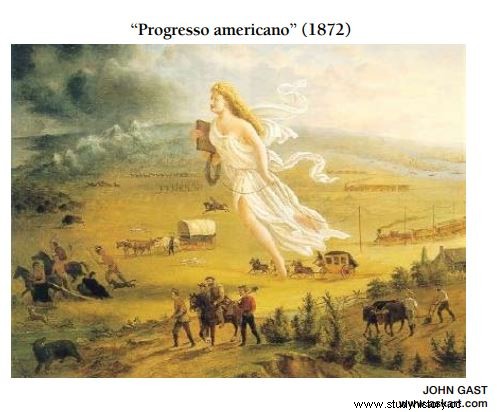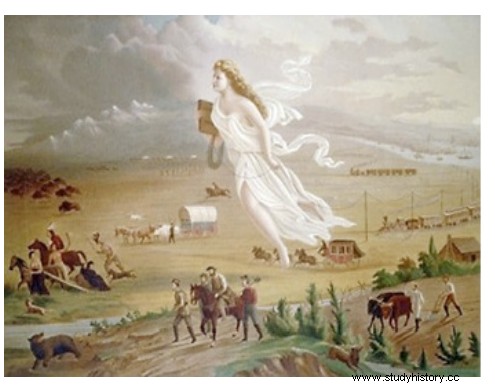
John Gast's canvas symbolizes the spread of material progress, such as railroads and the telegraph, in the USA during the 19th century. These changes contributed to the conquest of new territories and were justified by the following set of ideas:(A) Monroe Doctrine(B) Big Stick Policy(C) Good Neighbor Policy(D) Manifest Destiny Doctrine
Question 02 - FUVEST 2005 - Transfer – In the United States of the first half of the 19th century, the notion gained strength that Americans were an elected people, with a special mission to fulfill. This idea was called a) Bill of Rights.b) Manifest Destiny.c) America for the Americans.d) Big Stick.e) The Conquest of the West.
Question 03 - UERJ 1997 - 1st Phase - History - We must forever maintain the principle that only the people of this continent have the right to decide their own destiny. If, perhaps, a part of that people, constituting an independent state, wanted to join our Confederation, this would be a question that only they and us would be able to determine, without any foreign interference. (President Polk's first annual message to the United States Congress. In:SYRETT, H.C., ed. Historical Documents of the United States. São Paulo, Cultrix, s/d.) The above speech, dated December 2, 1845, reaffirmed the President Polk's belief in the expansion of American territory. The set of ideas that best explains this belief is:(A) the New Deal (B) the Truman Doctrine (C) Manifest Destiny (D) the Good Neighbor Policy
Question 04 - FUVEST 2014 - 1st Phase - The idea of occupation of the continent by the American people also had popular roots, in common sense and also in religious foundations. The dream of extending the principle of “unity” to the Pacific was called “Manifest Destiny”. Nancy Priscilla S. Naro. The formation of the United States. São Paulo:Atual, 1986, p. 19. The concept of “Manifest Destiny”, coined in the United States in the 1840s, a) spread the idea that the Americans were a chosen people and contributed to justify the opening of borders and the expansion towards the West. b) it had its origins in Jewish doctrine and emphasized that men should fear God and respect all others, regardless of their ethnicity or social position. c) it was based on the principle of multiculturalism and prevented the propagation of racist projects or ideologies in the South and in the North of the United States.d) derived from Calvinist principles and rejected the valorization of individualism and adventurism in military campaigns of territorial conquest, privileging actions coordinated by the State.e) defended the need to preserve nature and prevented the continuation of wars against indigenous people, in the conquest of the Center and West of North American territory.
Question 05 - UNESP - 2017 - 1st phase - The territorial expansion of the United States in the 19th century was the result of the purchase of French Louisiana by the central government, the annexation of Mexican territories, the distribution of small plots of land to pioneer settlers, the expansion of railroad networks, as well as the annexation of indigenous lands. This expansionist process was ideologically justified by the doctrine of Manifest Destiny, according to which a) the law belongs to the most democratic and industrious peoples. b) the world must be transformed for the aggrandizement of humanity. c) the American people must ensure the economic survival of pagan societies. d) the lands belong to their discoverers and first occupants. e) the nation must conquer the continent that Providence has reserved for it.
Question 06 - Mackenzie 2003/2 - The population that, in 1790, was almost 4 million inhabitants, rose to around 31 million in 1860. Ten years later, it reached 40 million. A good part of this contingent was formed by foreigners:between 1830 and 1860 almost 5 million European immigrants entered the country. José Robson de A. Arruda and Nelson Piletti The History of the United States of America, with regard to the phase of internal expansionism and the occupation and settlement of the current North American territory, was justified by the Doctrine of Manifest Destiny, on the which is INCORRECT to state that:
a) it explained a racist vision that acted as moral nourishment for the development of the nation.
b) its objectives were never used to legitimize invasions, interventions or territorial conquests in countries of the continent American.
c) it was based on a feeling of superiority of the white European immigrant over the Indians and the Mexicans.
d) it contains elements inspired by Social Darwinism, in which social relations emphasize the survival of the more capable.
e) the North Americans had been predestined by God to conquer the territories located between the Atlantic and Pacific oceans.
Question 07 - FGV RJ - 2015 - Throughout the 19th century, the so-called “March to the West” allowed the territorial expansion of the United States. In relation to this process, mark the correct alternative.
a) The expression “Manifest Destiny” justified expansionism, relating it to a kind of civilizing mission on the part of the Americans.
b) Territorial expansion was prevented because the French population of Louisiana refused to join the American Federation.
c) The Mexican government recognized the civilizational superiority of the United States and ceded territories such as Texas and California.
d) The regime of large property, predominant in the territories of the West, attracted large migratory flows.
e) The construction of railroads, which accelerated the expansion to the West, was made possible thanks to the purchase of indigenous lands.
br />Question 08 - UNESA/Estácio de Sá (Medicine) - 2015.2 - Arcos da Lapa -

Manifest Destiny was an ideological current that ended up being fundamental to:
1. The March to the West in the United States, which expanded the borders and massacred the Amerindians.
2. The American ideal based on the Protestant principle of predestination that served social aspirations.
3. The expansionist ideal that identified the east coast as the new Holy Land.
4. Several religious groups participated and established themselves in this movement, one of the most famous is the formation of the Mormons.
We can say that:
a) 1 and 2 are true.
b) 3 and 4 are true. false.
c) 3 and 4 are true.
d)1 and 3 are false.
e)1, 3 and 4 are true.
TEMPLATE 01 - D
02 - B
03 - C
04 - A
05 - E
06 - B
07 - A
08 - A
